Knowde Enhanced TDS
Identification & Functionality
- Polymer Name
- CASE Ingredients Functions
- Composite Materials Functions
- Plastics & Elastomers Functions
- Technologies
- Product Families
- Molecular Structure

Features & Benefits
- CASE Ingredients Features
- Materials Features
- Features
- Highly adhesive to metal, porcelain, concrete
- Excellent insulation property
- High heat resistance
- High chemical resistance
- High water resistance
- Product Highlights
- Liquid type (easy to handle)
- Excellent Tranparency even after full-curing
- Adhesion
- High Photo cure rate
- Low chlorine level
Applications & Uses
- Markets
- Applications
- Compatible Substrates & Surfaces
- Cure Method
- Coating Type
- Plastics & Elastomers End Uses
- Usage & Application
- Photocure process (UV/LED)
- LED/OLED encapsulant
- LED reflector
- Adhesives for optical devices, electro-optic assemblies, and laser components.
Properties
- Physical Form
- Appearance
- Colorless liquid
- Typical Physical Properties
- Physical Properties
- Typical Properties
- Properties Formulation
Value Unit Method jER™ YX8000D 100 - phr Other company’s hydrogenated bisphenol A type epoxy - 100 Anhydride curing agent (Methylhexahydrophthalic anhydride/Hexahydrophthalic anhydride = 70/30) 89 77 phr Curing accelerator (Methyltributylphosphonium dimethylphosphate) 1 1 phr Gel time @ 120 °C 30 36 Curing condition 100°C/3h + 130°C/3 h
Cured State Properties Tg (tanδ) 135 - °C Dynamic Mechanical Analysis
Elastic modulus @ 30 °C 3.4 - GPa Dynamic Mechanical Analysis
Elastic modulus @ 220 °C 17 - MPa Dynamic Mechanical Analysis
Tg 136 110 Thermo Mechanical Analysis
Coefficient of Thermal Expansion (α1) 68 75 ppm Thermo Mechanical Analysis
Coefficient of Thermal Expansion (α2) 172 186 ppm Thermo Mechanical Analysis
Moisture absorption rate
72hr 0.8 0.9 % 85°C 85%RH
168hr 0.83 0.92 % Light resistance (Weathermeter, 0.4kw/m^2)
Yellowness index
0hr 1 1 - 168hr 7 16 - Light transmittance at 360 nm
0hr 86 85 % 168hr 53 35 %
| Value | Units | Test Method / Conditions | |
| Refractive Index (589nm) | 1.50 | — | D line |
| Value | Units | Test Method / Conditions | |
| Density (at 25°C) | 1.1 | g/cm3 | Density Meter (Vibration type) |
| Value | Units | Test Method / Conditions | |
| Epoxy Equivalent Weight (WPE) | 175 - 195 | g/eq | Potentiometric Titration |
| Chloride Content | max. 1200 | ppm | Potentiometric Titration |
| Viscosity (at 25°C) | max. 1500 | mPa.s | Capillary Viscometer |
Technical Details & Test Data
- Photo Curability Data
YX8000D significantly decreases photo curing time to reach sufficient crosslinking reaction level compared to a conventional CER.
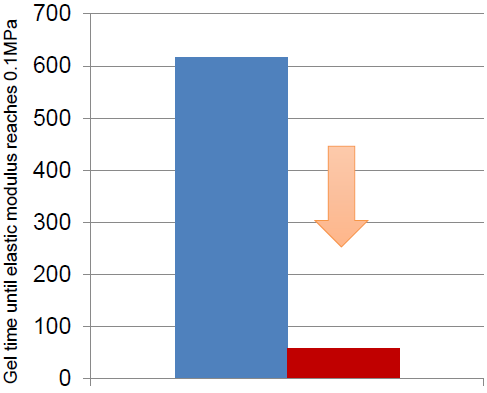
CER: Cycloaliphatic epoxy resin
Light source 200mW/cm2, no filter, 25°C
Photo cationic catalyst CPI 100P San Apro Ltd.- Transparency of jER YX8000D
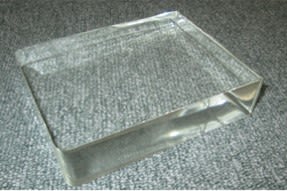
- Izod Impact Strength Data
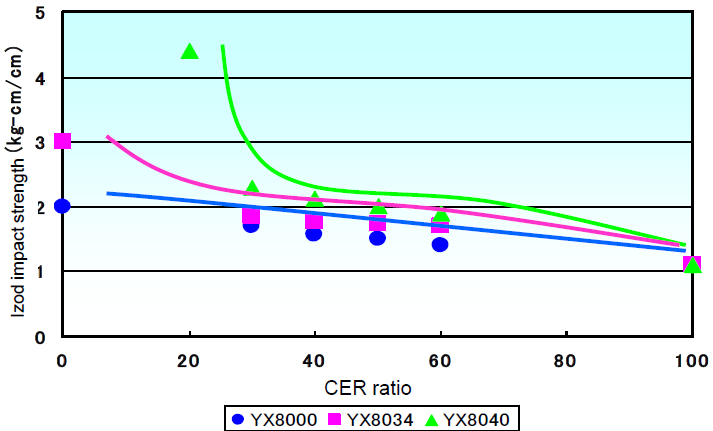
- Transparency Data of YX8000 Series
Transparency data of YX8000*
High transparency can be achieved by YX8000D.
*YX8000 is a former version of YX8000D with higher Cl impurity.
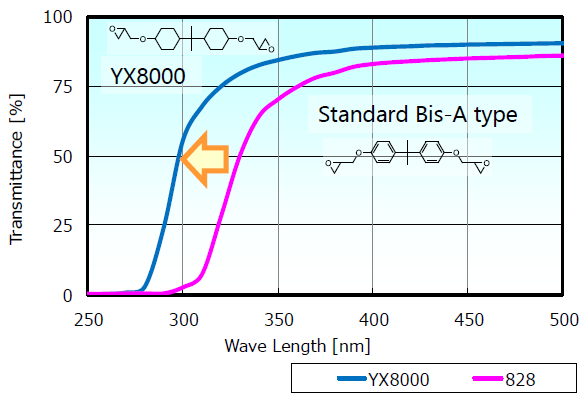
Curing condition: 100°C x 3hr + 130°C x 3hr
Curing agent: Acid anhydride type- Typical Reactions with Representative Hardeners
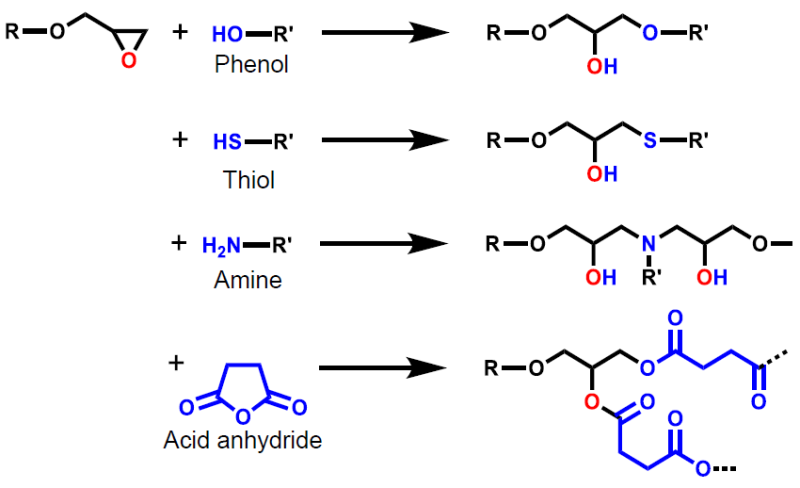
- Adhesion Improvement Data of YX8000
YX8000 addition to CER improves adhesiveness to metal substrates.
*YX8000 is a former version of YX8000D with higher Cl impurity.Share adhesive strength
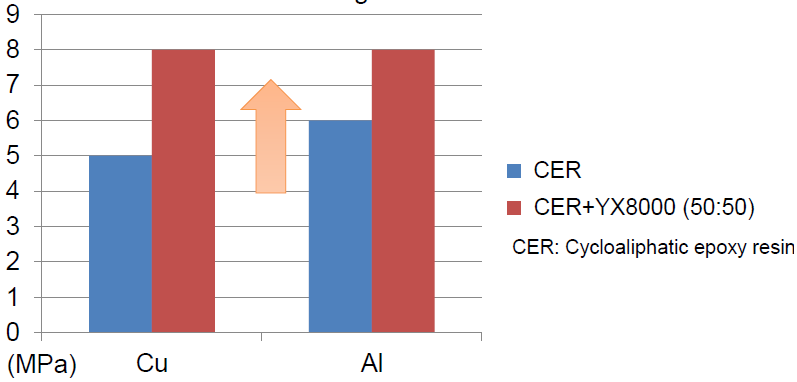
Curing condition: 100°C x 3hr + 130°C x 3hr
Curing agent: Acid anhydride type
Share adhesive strength test: ISO4587 (JIS K 6850)- Typical Reactions with Self Polymerization
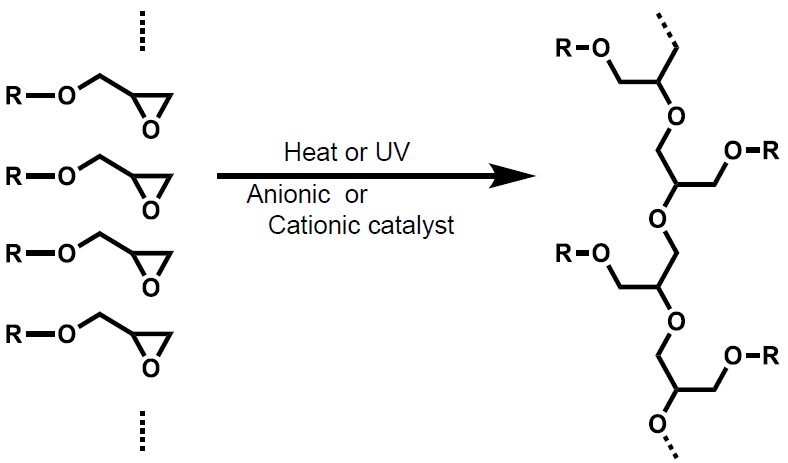
- Selection of Hardeners
Appropriate choice of Hardener for a desired curing temperature
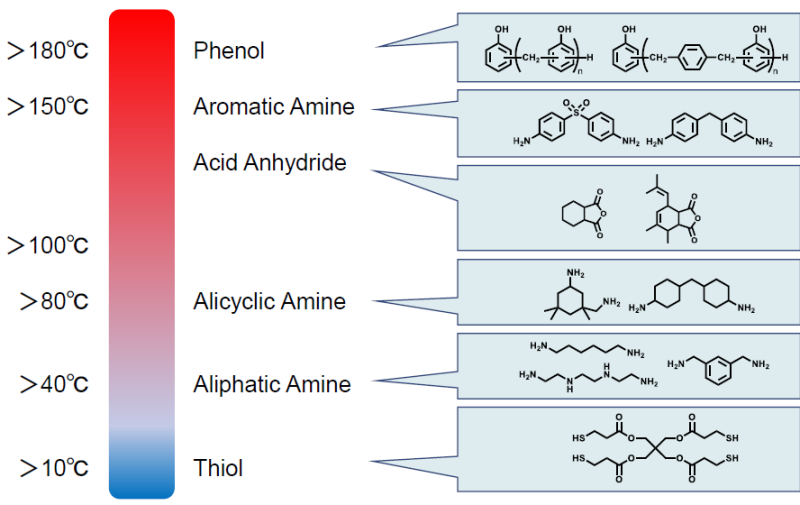
- General Ways to Use Epoxy
- Epoxy resin forms 3D crosslinked network structure
- Abundant choices of Epoxy/Hardener combination
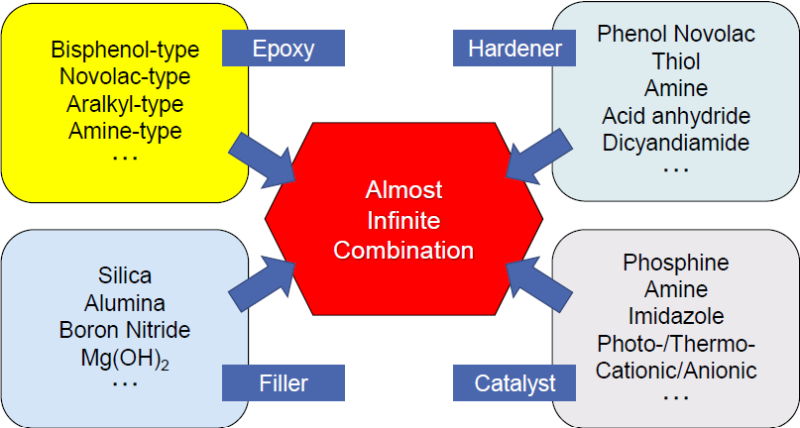
Packaging & Availability
- Packaging Information
- Steel drum with 200 kg net and metal can with 20 kg net
Storage & Handling
- Shelf Life
- 3 months
- Storage and Handling
Carefully read the SDS before using, handling, transporting, storing or disposing. jER™ YX8000D should be stored in tightly closed containers under exclusion of humidity at gentle temperatures. Avoid exposure to direct sunlight. Under these storage conditions the product has a minimum shelf life of three months from date of delivery.